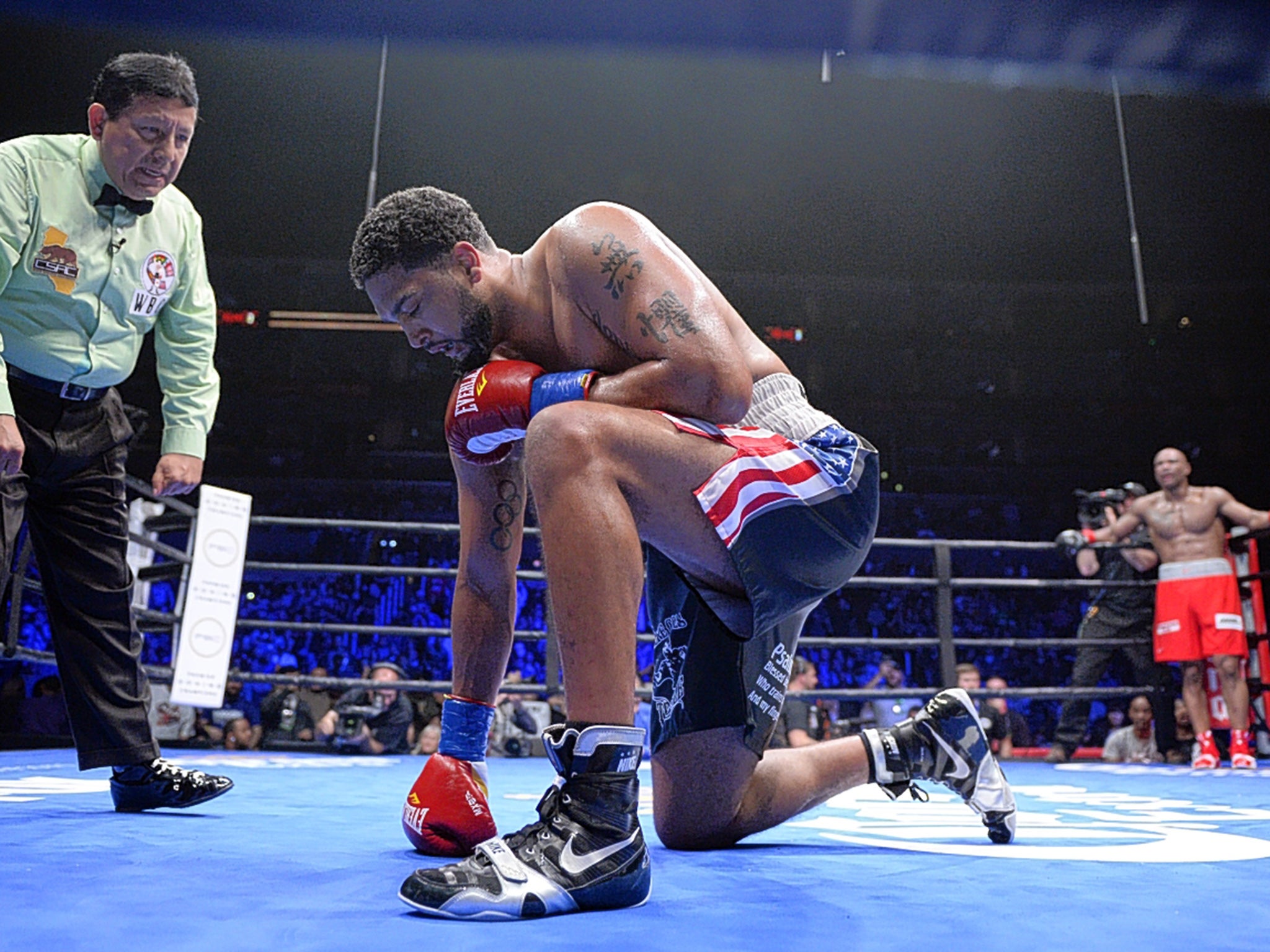Dominic Breazeale follows path of boxing’s man mountains, writes Steve Bunce
Former quarterback turned heavyweight recalls tradition of massive men with no natural fighting talent – like monstrously exploited Carnera, writes Steve Bunce

Budd Schulberg arrested Leni Riefenstahl, won an Academy award and also wrote about manufactured heavyweights.
Last Saturday in Los Angeles the latest heavyweight to emerge, towering and threatening from the dream factory, extended his record to 17 fights without defeat and Budd would have loved every second of it.
Dominic Breazeale is 6ft 7in, close to 19st and was a successful American footballer, a quarterback destined for glory, before the fight whisperers convinced him of the riches a man with his size, power and desire could make in the boxing ring. He flopped at the London Olympics but a steady diet of the willing took him to 16 and zero before his fight with Amir Mansour at the Staples Centre last weekend.
In round three Breazeale, who was six inches taller and three stone heavier than 43-year-old Mansour, was sent crashing to the canvas.
It looked like the considerable investment was over, but Breazeale survived, showed tremendous guts and at the end of round five Mansour quit with a broken jaw and a ripped tongue that required 36 stitches. Mansour, whose career was interrupted for nearly 10 years when he went to prison, was Breazeale’s first test. Not all the plastic heavies come through the first test.
Breazeale is not the first nor the last of the big men to succumb to the promises of boxing’s fixers, shift sports and go out swinging in search of the money and fame. He is part of a rich tradition of men with no natural fighting talent having to balance their limitations in desperate struggles against men who can really fight.
Britain's current boxing world champions
Show all 8In the late 1920s an ambling giant from Italy called Primo Carnera, who was 22lb at birth and had a head like a bison, was dropped by a travelling circus because he ate too much and delivered too little.
He was, so the tale goes, discovered one day in the south of France on a park bench begging for a sou, desperate for a croissant and attracting attention because of the way he looked. Carnera had bewildering dimensions for his day and was 6ft 7in and 19st, just like Breazeale.
Carnera eventually washed up on the filthy American boxing beach in 1930 and was instantly divided into ownership portions that no mathematician’s beautiful mind could solve. It was a merciless process to transform the human freak, a fighting Goliath, into a contender and, with the protection of hoodlum owners, he started to win fights and move closer to the heavyweight championship of the world.
There are tales of guns being shown to fighters between rounds, visits to dressing rooms by men with machine guns before fights and a host of other intimidation rituals to make sure nobody threw a punch in anger at Primo in a sparring session or a fight.
Schulberg saw the carnage, it inspired him to rage and he took to his typewriter, pounded the same keys that would later produce the delicious lines from Terry Malloy in On the Waterfront: “I coulda had class. I coulda been a contender. I coulda been somebody instead of a bum.”
Marlon Brando won the Oscar playing Malloy, the broken boxer, and Budd got the screenplay gong. The lines surface again when Robert De Niro, playing Jake LaMotta, uses them in the heart-breaking opener of Raging Bull. Schulberg always told me that LaMotta was a pest.
In Schulberg’s novel about manipulated fighters, The Harder They Fall, published in 1947, the heavyweight world of fixed fights, gangsters and the standard abuse of fighters is told with few concessions; the tragic story of a hapless pawn in the boxing business called Toro Moreno, a gentle giant from Argentina, is simply Carnera by another name; he was a man mountain there for exploitation.
In 1933 Carnera won the heavyweight world title when Jack Sharkey fell over in round six. The following year Max Baer dropped Carnera 13 times before the massacre was stopped in round 11 in front of 58,000 people at Madison Square Garden in New York.
Carnera’s world title was gone, as was the $2m he had been paid. He was abandoned by the men who found him, made him and used him. He continued in the ring, was battered in several fights and then fought on the wrestling circuit, a business no less vicious than the boxing game.
Schulberg was a silent, cold observer to it all and he made Moreno from Carnera’s ashes. “There is a lot of bad in the boxing business,” he told me at his club in New York. “But it’s our business.” Budd is right, it is a business where men like Breazeale walk firmly in the giant footsteps of men like Carnera and Moreno.
Subscribe to Independent Premium to bookmark this article
Want to bookmark your favourite articles and stories to read or reference later? Start your Independent Premium subscription today.

Join our commenting forum
Join thought-provoking conversations, follow other Independent readers and see their replies